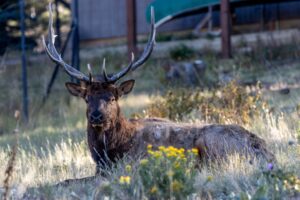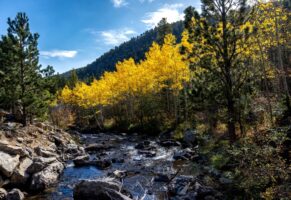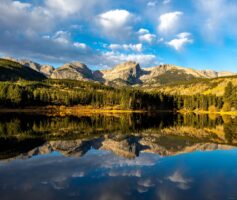Preparing for a trip in the Great Outdoors can be challenging, especially when it comes to choosing the right clothing to keep you both comfortable and safe. If you’re wondering what to pack and wear for a trip to Rocky Mountain National Park, based on our experience, we felt it worthwhile to dedicate an entire blog post to this topic. This blog will guide you on what to pack and wear for a trip to Rocky Mountain National Park so you can be well-prepared.
Planning for the Weather
Our trip took place in early October. Traveling in the fall can be tricky because the weather can shift dramatically from one day to the next. We tend to overpack for most trips and spent time researching the recommended gear for Rocky Mountain National Park around this time. Even after our research, we still overpacked!
We hope our experience helps you pack more efficiently while still being prepared for the wide range of weather conditions you might encounter on the trails. The most common piece of advice you’ll hear is: “Dress in layers.” The weather in the mountains is unpredictable, and a day can range from sunny to snowy in a matter of hours. Keep in mind:
- If snow is in the forecast, roads and trail access might be limited.
- Consider booking accommodations that offer reimbursement or travel insurance.
- Use apps and websites like Windy to monitor weather changes.
Luckily for us, we had a full week of sunshine and gorgeous fall weather. However, always stay vigilant: fall weather can be unpredictable, so being prepared is essential.
Dressing in Layers
When people say, “dress in layers,” what does that really mean? It’s a three-part system:
- Base Layer: Moisture-wicking to keep you dry.
- Middle Layer: Provides insulation to keep you warm.
- Outer Layer: Protects you from wind, rain, and snow.
Below, we’ve broken down the specific items we used to stay comfortable all week long. These are personal preferences and not sponsored recommendations.
Base Layer
- Vermont Merino Wool Socks
I discovered these socks on a trip to Vermont (go figure!) and have been hooked ever since. They’ve been a game changer in keeping my feet warm. I now add them to my Christmas list every year. - Thermal Underwear Base Layer
We highly recommend Convallaria or Meetyou brand thermals. They’re warm, comfortable, and budget-friendly. We only needed these for our early-morning sunrise hikes—other times of day, they weren’t necessary. Don’t make my mistake and pack too many pairs; you only need one or two. - Running Tights
My wife prefers tights as a base layer for moisture-wicking warmth. If tights aren’t your thing, stick with thermals.
Middle Layer
- Fleece Jacket
I wore my lightweight fleece jacket more often than my heavier outer layer. Make sure your fleece is slim enough to fit comfortably under a larger jacket if needed. - Moisture-Wicking Shirt
Whether short-sleeve or long-sleeve, polyester/spandex blends are ideal for wicking moisture and drying quickly. Avoid 100% cotton because it retains moisture and loses insulation when wet. - Flannel
A flannel shirt is another good middle-layer option. My wife wore one regularly; I stuck with the fleece.
Outer Layer
- Kuhl Pants (or Similar Brands)
Look for pants that are moisture-wicking, quick-drying, and offer UPF protection. PFAS-free options are a plus. We wore Kuhl pants all week. - Hiking Boots
In summer, we might wear hiking shoes, but for fall, we both opted for GORE-TEX waterproof boots to keep our feet dry. - Lightweight, “Warmer” Hoodie or Jacket
Both of our jackets were labeled “Warmer” by REI. Water resistance is a bonus, but you should also pack a separate rain jacket or poncho. You’ll find a wide range of options and prices, so choose what fits your comfort level and budget. I found mine on clearance—score! - Raincoat or Poncho
Quick rainstorms are not uncommon, even in fall, so keep a raincoat or poncho with you at all times. My wife bought a raincoat but never had to use it. - Hat and Gloves
We can’t say enough good things about the Xtreme All Weather Gloves. They’re pricey but worth it if you hate cold hands. We also wore simple beanies, and my wife used a running cap for added sun protection during hikes.
Other Essential Gear
Clothing isn’t the only thing you’ll need. For hikes and general exploration, we recommend the following:
- Headlamp
Crucial for pre-sunrise or post-sunset hikes. We used a model with a wave function that lets you turn it on/off with a hand motion—very convenient when wearing gloves. - Backpack
I used a photography-specific pack for my camera gear. My wife used the REI Trail Backpack, which she loved for carrying supplies (while I carried lenses). - Vacuum Water Bottles
Bring a large bottle for the car and a smaller one for the trail. You’ll need to stay hydrated at higher altitudes—plan on around 16 ounces (0.5 liters) per hour. Above 8,000 feet, you should increase water intake by 25–50%. Why not use a Stanley, you’re in the town of the guy who invented it! - Cooler
We ended up buying a cooler at a local liquor store, which wasn’t easy to find. If you want one, consider bringing a foldable cooler in your luggage instead of relying on local availability.
Final Thoughts
Visiting Rocky Mountain National Park in the fall can be an incredible experience, filled with stunning landscapes and crisp mountain air. Staying prepared and dressing in layers will help you enjoy everything the park has to offer, regardless of what Mother Nature decides. This guide focused on what to pack and wear for a trip to Rocky Mountain National Park, should have you covered for all scenarios for a fall voyage.
Pack wisely, pay attention to weather forecasts, and make the most of your adventure!




